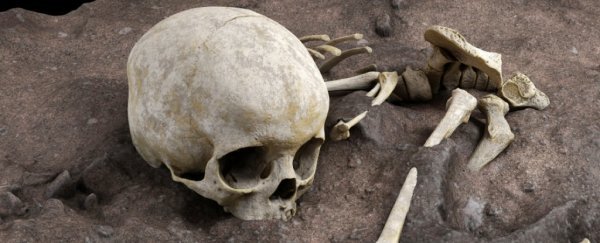Around 78,000 years ago, in what is now Kenya, a three-year-old child died.
History is full of dead humans and human ancestors of all ages – dying is something everyone does, sooner or later – but this child was special. The evidence suggests that he or she was carefully laid to rest in a deliberate burial, at the mouth of the Panga ya Saidi cave.
This makes the child, named Mtoto by archeologists after the Swahili word for ‘child’, the earliest known example of deliberate burial by modern humans (Homo sapiens) in Africa.
“As soon as we first visited Panga ya Saidi, we knew that it was special,” said archeologist Nicole Boivin of the Max Planck Institute for the Science of Human History.
“The site is truly one of a kind. Repeated seasons of excavation at Panga ya Saidi have now helped to establish it as a key type site for the East African coast, with an extraordinary 78,000-year record of early human cultural, technological, and symbolic activities.”

The remains were first discovered in 2013, about 3 meters (9.8 feet) below the current cave floor, in a pit-shaped feature, indicating that they had been buried. The small, delicate bones were so fragile and decomposed they couldn’t be excavated at the time.
It wasn’t until 2017 that the bones could be plastered, right there on site, to be returned to the laboratory of the National Research Center on Human Evolution (CENIEH) in Spain for detailed excavation and analysis.
Mtoto was worth the additional wait.
“We started uncovering parts of the skull and face, with the intact articulation of the mandible and some unerupted teeth in place,” said archeologist María Martinón-Torres of CENIEH.
“The articulation of the spine and the ribs was also astonishingly preserved, even conserving the curvature of the thorax cage, suggesting that it was an undisturbed burial and that the decomposition of the body took place right in the pit where the bones were found.”

Two teeth discovered during analysis allowed the research team to confirm the child’s age, and microscopic and chemical examinations of the bones and surrounding sediment revealed more details.
Mtoto had been laid to rest in a hole, and covered over with sediment from the cave floor. The fact that decomposition took place in this hole means that the burial took place not long after death.
The positioning of the bones suggests that Mtoto was buried on their right side, with their knees drawn up to the chest, and tightly wrapped in a shroud. Since no trace of this shroud remains, it would have been made of perishable material.
The post-mortem dislocation of Mtoto’s head suggests that some sort of support or pillow, also of perishable material, had been placed there and disintegrated, strongly suggests funerary practices took place at the burial site.

Signs of ancient deliberate burials have been found in other parts of the world, spanning 800,000 years, but most of those have been other species of the Homo genus, such as Homo antecessor, Homo naledi, and Homo neanderthalis.
This discovery is significant because it helps us understand how early Homo sapiens treated their dead – practices that have links to social organization, spiritual and symbolic beliefs and behaviors, technology, and community priorities.
For example, another burial of a Homo sapiens child 74,000 years ago in South Africa’s Border Cave might suggest that the deaths of young children were events over which special care was taken – although with a sample size of just two burials, it’s impossible to know for sure.
Mtoto was also found in archeological layers that included stone tools. Previously, it was unclear which species of the Homo genus had used these tools; Mtoto’s contemporary burial suggests that it was Homo sapiens after all.
Even so, the evidence of Mtoto’s burial – and its similarities to that of other previously found Homo species burials – hints that cultural practices and artifacts may not have been so clearly delineated between species.
“Inhumation of the dead is a cultural practice shared by Homo sapiens and Neanderthals,” said anthropologist Michael Petraglia of the Max Planck Institute.
“This find opens up questions about the origin and evolution of mortuary practices between two closely related human species, and the degree to which our behaviors and emotions differ from one another.”
The research has been published in Nature.



